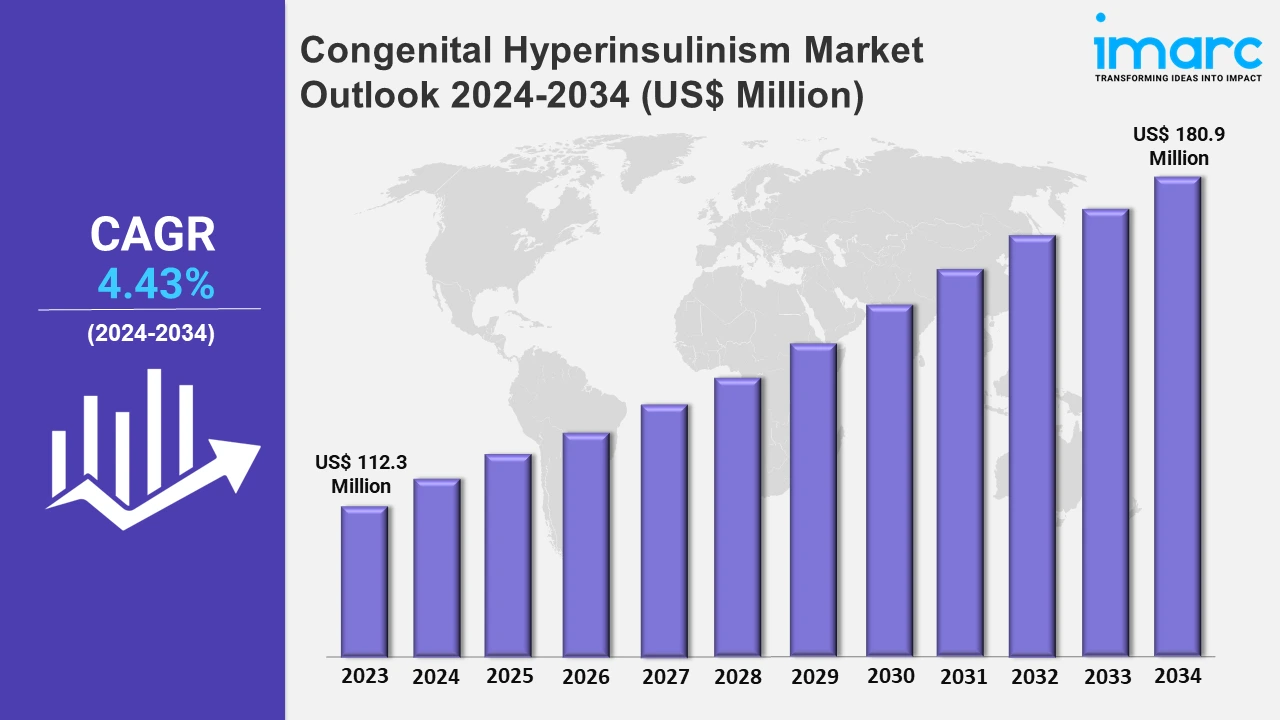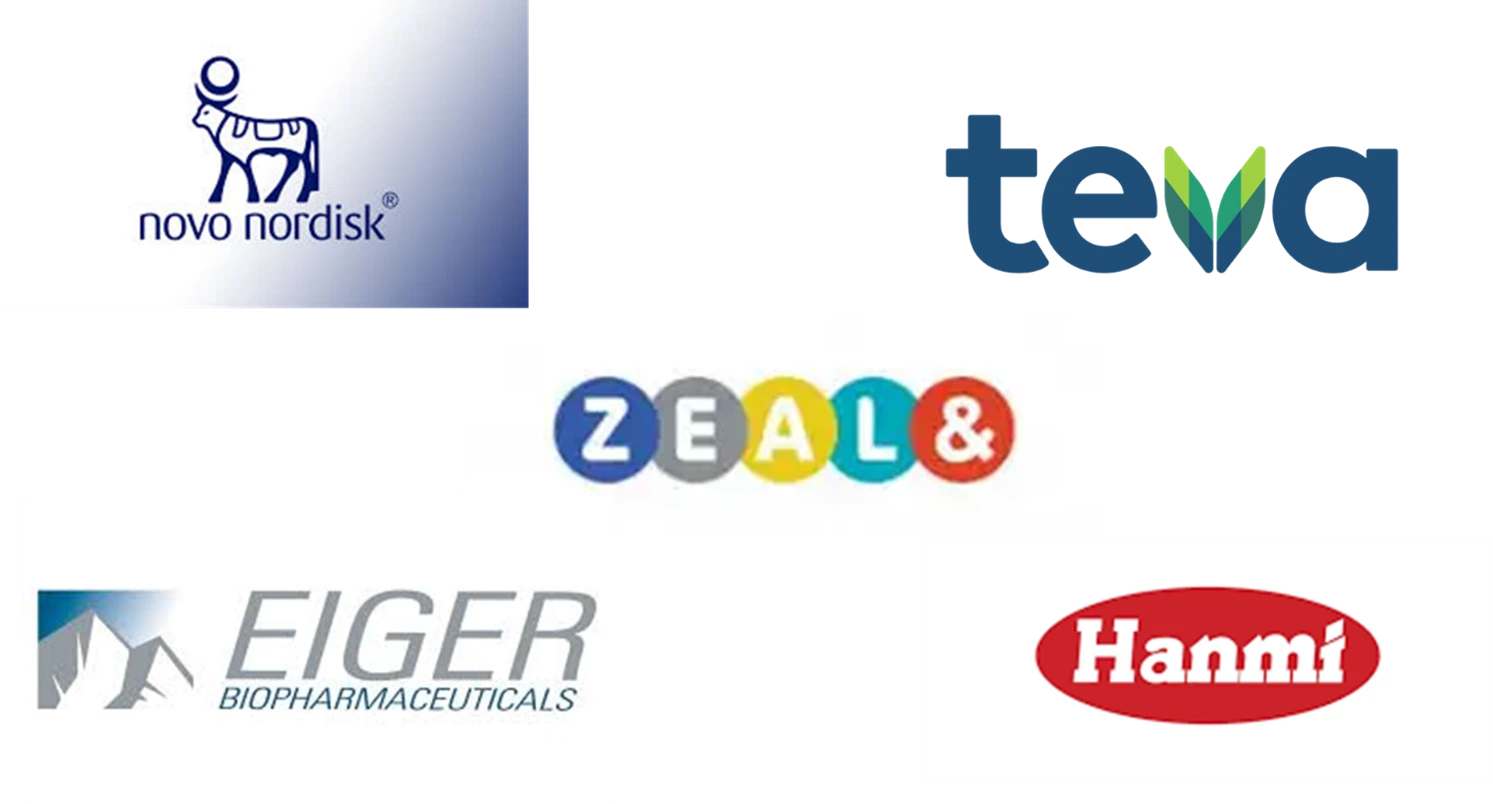Congenital Hyperinsulinism Market Size to Reach US$ 180.9 Million by 2034, Impelled by Advancements in Early Detection
Congenital Hyperinsulinism Market Outlook 2024-2034:
The congenital hyperinsulinism market size reached a value of US$ 112.3 Million in 2023. Looking forward, the market is expected to reach US$ 180.9 Million by 2034, exhibiting a growth rate (CAGR) of 4.43% during 2024-2034. The market is driven by the escalating demand for gene therapy, since it involves introducing functional genetic material into cells, thereby rectifying or replacing malfunctioning genes linked to the disorder.

To get more information on this market, Request Sample
Advances in Early Detection and Diagnostic Technologies: Driving the Congenital Hyperinsulinism Market
Advances in early detection and diagnostic technologies are playing a critical role in driving the congenital hyperinsulinism (CHI) market, as they enable earlier diagnosis, more precise treatment, and improved patient outcomes. Recent advancements in diagnostic technologies have greatly enhanced the ability to identify this condition early, reducing the risk of long-term complications. One of the key drivers in early detection is the use of genetic testing, which has significantly improved the diagnosis of CHI. Next-generation sequencing (NGS) technologies allow for the identification of mutations in genes associated with CHI, such as ABCC8, KCNJ11, and others, facilitating a more accurate and rapid diagnosis. This is particularly valuable for differentiating between the different forms of CHI, including focal and diffuse types, which require distinct treatment approaches. In addition to genetic testing, biomarkers for CHI are being explored to identify patients at risk for the condition, even before clinical symptoms manifest. This could lead to the implementation of screening programs, allowing for earlier intervention and better disease management. Non-invasive imaging technologies, such as PET scans and magnetic resonance imaging (MRI), are also playing an increasing role in identifying focal lesions in the pancreas, which can guide surgical intervention. These advances in diagnostics are not only improving the speed and accuracy of CHI detection but also contributing to the development of more targeted and personalized treatment options. As diagnostic technologies continue to evolve, they are expected to drive the CHI market by facilitating earlier, more effective treatments and reducing the long-term healthcare burden of the disease.
Development of Novel Therapies and Pharmacological Treatments: Contributing to Market Expansion
The development of novel therapies and pharmacological treatments is a significant factor contributing to the expansion of the congenital hyperinsulinism (CHI) market. One of the most promising developments in the CHI market is the use of targeted pharmacological treatments. Newer drugs, such as glucagon-like peptide-1 (GLP-1) receptor agonists and ATP-sensitive potassium (KATP) channel modulators, are being investigated for their ability to specifically target the molecular mechanisms that drive CHI. These therapies offer the potential to better control insulin secretion, reduce hypoglycemic episodes, and improve the quality of life for patients. In addition, gene therapy is emerging as a cutting-edge approach for treating CHI, particularly in cases with genetic mutations. Researchers are exploring ways to correct defective genes responsible for insulin dysregulation, which could provide a long-term or permanent solution for affected individuals. Furthermore, surgical advancements, such as minimally invasive techniques for focal lesions, have also contributed to the overall market growth by offering more precise and less invasive options for patients with localized forms of CHI. Moreover, as these novel therapies and treatment modalities continue to evolve, they are expected to transform the CHI landscape, offering more personalized, effective, and safer treatment options, which will significantly contribute to the expansion of the congenital hyperinsulinism market.
Marketed Therapies in Congenital Hyperinsulinism Market
Proglycem (Oral Diazoxide): Teva Pharmaceuticals
Proglycem (Oral Diazoxide), a nondiuretic benzothiadiazine derivative, is a medicine used to treat low blood sugar caused by a variety of conditions. Proglycem decreases insulin release by activating the ATP-sensitive potassium channel of pancreatic beta cells, hence it is used to treat hypoglycemia in conditions such as congenital hyperinsulinism.
Emerging Therapies in Congenital Hyperinsulinism Market
HM15136: Hanmi Pharmaceutical
HM15136 is a new long-acting glucagon analog coupled with a human IgG Fc fragment, offering a longer half-life than standard glucagon. HM15136 functions similarly to glucagon, a hormone that helps the body maintain appropriate blood sugar levels. The drug works to increase the quantity of glucose in the body by breaking down glycogen and increasing the amount of glucose generated in the liver. HM15136 may improve the quality of life for people with congenital hyperinsulinism and boost medication adherence.
Dasiglucagon: Zealand Pharma/Novo Nordisk
Dasiglucagon is under investigation as a potential therapy for congenital hyperinsulinism. Dasiglucagon is a derivative of glucagon, a peptide hormone that raises blood glucose levels. It works similarly to endogenous glucagon, acting as an agonist at glucagon receptors, which are G-coupled receptors found throughout the body. Dasiglucagon binds to glucagon receptors in the liver, activating Gsα, Gq, and adenylate cyclase. Adenyl cyclase raises intracellular cyclic AMP, which promotes glycogenolysis and glucogenesis in the liver. As glucose is largely released from liver glycogen stores, hepatic glycogen stores are critical for dasiglucagon to exert its antihyperglycemic actions.
Avexitide: Eiger BioPharmaceuticals
Avexitide is a drug developed by Eiger BioPharmaceuticals to treat congenital hyperinsulinism. It is an investigational, first-in-class glucagon-like peptide-1 (GLP-1) receptor antagonist that has been studied in congenital hyperinsulinism with FDA Rare Pediatric Disease Designation. Avexitide is intended to bind to the GLP-1 receptor on pancreatic islet beta cells, inhibiting the effect of excessive GLP-1 on hypoglycemia by lowering insulin production and stabilizing glucose levels.
| Drug Name | Company Name | MOA | ROA |
|---|---|---|---|
| HM15136 | Hanmi Pharmaceutical | Glucagon receptor agonists | Subcutaneous |
| Dasiglucagon | Zealand Pharma/Novo Nordisk | Glucagon receptor agonists | Subcutaneous |
| Avexitide | Eiger BioPharmaceuticals | Glucagon-like peptide-1 receptor antagonists | Subcutaneous |
Detailed list of emerging therapies in Congenital Hyperinsulinism is provided in the final report.
Leading Companies in the Congenital Hyperinsulinism Market:
The market research report by IMARC encompasses a comprehensive analysis of the competitive landscape in the market. Across the global congenital hyperinsulinism market, several leading companies are at the forefront of developing integrated platforms to enhance the management of congenital hyperinsulinism. Some of the major players include Teva Pharmaceuticals. These companies are driving innovation in the congenital hyperinsulinism market through continuous research, diagnostic tools, and expanding their product offerings to meet the growing demand for the illness.
Key Players in Congenital Hyperinsulinism Market:
The key players in the Congenital Hyperinsulinism market who are in different phases of developing different therapies are Teva Pharmaceuticals, Hanmi Pharmaceutical, Zealand Pharma, Novo Nordisk, Eiger BioPharmaceuticals, and Others.

Regional Analysis:
The major markets for congenital hyperinsulinism include the United States, Germany, France, the United Kingdom, Italy, Spain, and Japan. According to projections by IMARC, the United States has the largest patient pool for congenital hyperinsulinism while also representing the biggest market for its treatment. This can be attributed to enhanced genetic testing, including NGS, which allows for more accurate and rapid identification of the genetic mutations that cause congenital hyperinsulinism, leading to earlier intervention and better disease management.
Moreover, the availability of new pharmacological treatments and surgical techniques is fueling the market's growth. With innovations such as ATP-sensitive potassium (KATP) channel modulators and targeted therapies offering improved outcomes for patients, there is increased demand for novel treatments. These therapies provide more personalized approaches, especially for patients who do not respond to traditional treatments like diazoxide and octreotide.
Besides this, the U.S. healthcare system, with its robust infrastructure and focus on rare disease management, also plays a significant role in driving the market. Research funding, FDA orphan drug designations, and clinical trials focused on CHI have accelerated the development and availability of innovative therapies.
Recent Developments in Congenital Hyperinsulinism Market:
- In October 2024, Zealand Pharma announced that the United States FDA had issued a Complete Response Letter (CRL) for Part 1 of the New Drug Application (NDA) for dasiglucagon for the prevention and treatment of hypoglycemia in pediatric patients 7 days old and older with congenital hyperinsulinism for up to 3 weeks of dosing.
- In July 2024, Amylyx Pharmaceuticals, Inc. announced the acquisition of avexitide from Eiger BioPharmaceuticals, Inc. Avexitide is an investigational, first-in-class glucagon-like peptide-1 (GLP-1) receptor antagonist that has been evaluated in five Phase 2 clinical studies for post-bariatric hypoglycemia and congenital hyperinsulinism, with U.S. FDA Breakthrough Therapy Designation for both indications and Rare Pediatric Disease Designation in congenital hyperinsulinism.
Key information covered in the report.
- Base Year: 2023
- Historical Period: 2018-2023
- Market Forecast: 2024-2034
Countries Covered
- United States
- Germany
- France
- United Kingdom
- Italy
- Spain
- Japan
Analysis Covered Across Each Country
- Historical, current, and future epidemiology scenario
- Historical, current, and future performance of the congenital hyperinsulinism market
- Historical, current, and future performance of various therapeutic categories in the market
- Sales of various drugs across the congenital hyperinsulinism market
- Reimbursement scenario in the market
- In-market and pipeline drugs
Competitive Landscape:
This report offers a comprehensive analysis of current congenital hyperinsulinism marketed drugs and late-stage pipeline drugs.
In-Market Drugs
- Drug Overview
- Mechanism of Action
- Regulatory Status
- Clinical Trial Results
- Drug Uptake and Market Performance
Late-Stage Pipeline Drugs
- Drug Overview
- Mechanism of Action
- Regulatory Status
- Clinical Trial Results
- Drug Uptake and Market Performance
About Us:
IMARC Group is a global management consulting firm that helps the world’s most ambitious changemakers to create a lasting impact. Across the six major continents and 100+ countries, we work alongside our business partners as one team with a common ambition to achieve unparallelled results, gain a competitive edge, and transform industries. IMARC Group excels in understanding its clients’ business priorities and delivering tailored solutions that drive meaningful outcomes. Our client base spans over 3,000 organizations in the private, public, and social sectors, ranging from high-growth startups to Fortune 500 companies.
Contact US
IMARC Group
134 N 4th St. Brooklyn, NY 11249, USA
Email: Sales@imarcgroup.com
Tel No:(D) +91 120 433 0800
Phone Number: - +1 631 791 1145, +91-120-433-0800
Need more help?
- Speak to our experienced analysts for insights on the current market scenarios.
- Include additional segments and countries to customize the report as per your requirement.
- Gain an unparalleled competitive advantage in your domain by understanding how to utilize the report and positively impacting your operations and revenue.
- For further assistance, please connect with our analysts.

 Inquire Before Buying
Inquire Before Buying
 Speak to an Analyst
Speak to an Analyst
 Request Brochure
Request Brochure




.webp)




.webp)












